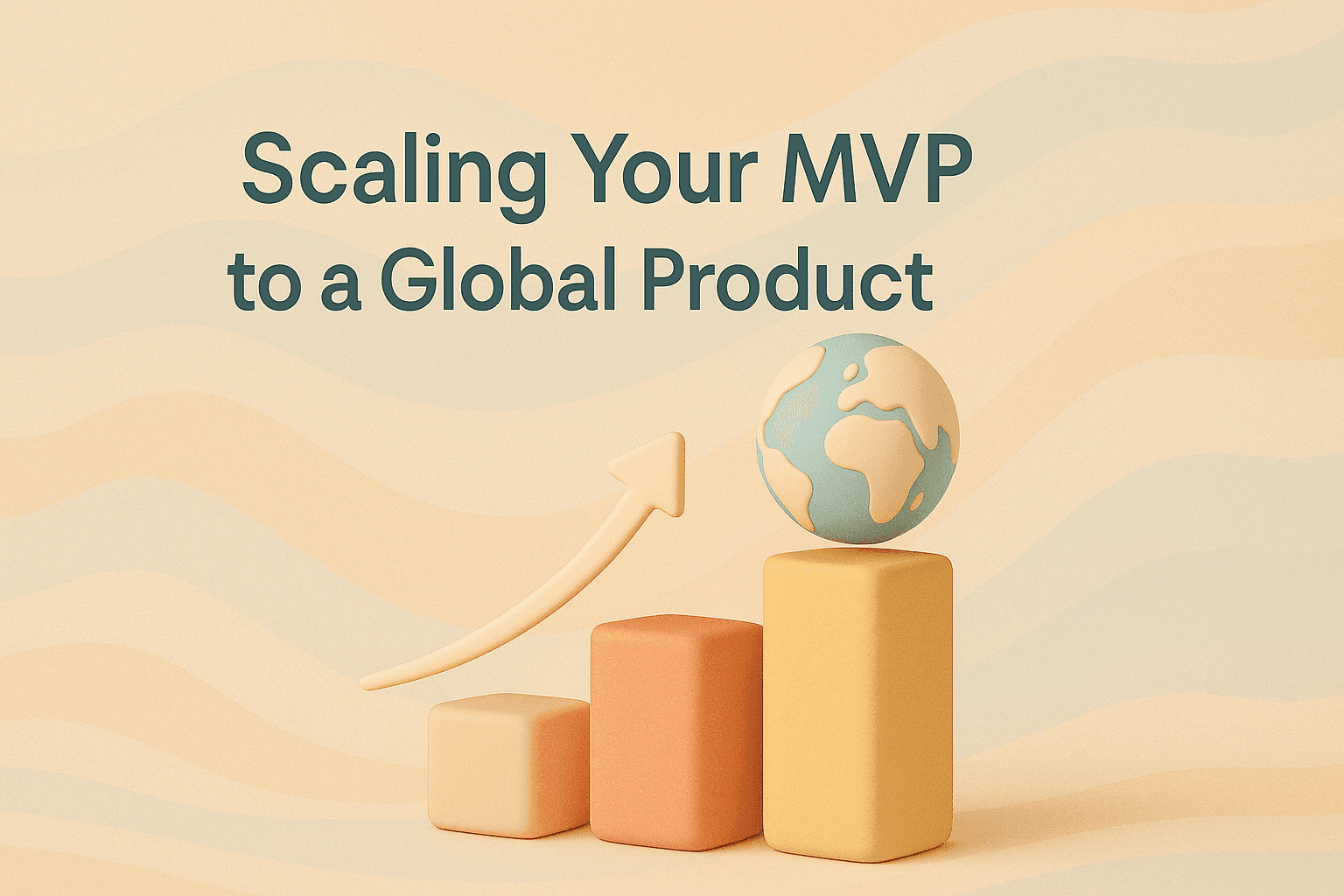Support center +91 97257 89197
MVP DevelopmentNovember 19, 2024
Beyond the MVP: Scaling Your Startup from Prototype to Global Product

In the fast-paced startup ecosystem, launching your Minimum Viable Product (MVP) is just the first milestone. As exciting as it is to validate your idea, the real challenge begins once you start scaling. Transitioning from a simple prototype to a global-scale product requires a strategic approach, disciplined execution, and adaptable infrastructure. In this guide, we’ll explore critical strategies and best practices to help your startup evolve from MVP status to a thriving global business.
Why Scaling Matters: The Leap from MVP to Global Impact
An MVP provides valuable insights, proving your idea resonates with the market. However, remaining static at this early stage can cause stagnation or even failure. Scaling strategically is vital for expanding your reach, maximizing profits, and cementing your position in the market. Successful scaling transforms your early successes into sustainable long-term growth.
Step 1: Validate Your Product-Market Fit Rigorously
Before scaling, it's imperative to solidify your product-market fit. Product-market fit occurs when your product perfectly meets market demands, creating organic demand and customer retention.
- Collect Customer Feedback: Actively solicit feedback to enhance product features and usability.
- Measure Engagement Metrics: Use metrics such as user retention, conversion rates, and NPS scores to quantify satisfaction and engagement.
Consistent positive metrics indicate readiness to scale.
Step 2: Establish a Solid Infrastructure Foundation
Infrastructure is the backbone of your scaling efforts. It's crucial to build robust, flexible infrastructure early on to handle anticipated growth effectively.
- Cloud Services: Leverage scalable platforms like AWS, Google Cloud, or Azure to manage increased traffic smoothly.
- CI/CD Pipelines: Automate deployment and continuous integration processes to maintain stability as you iterate.
- Microservices Architecture: Transition from monolithic applications to microservices for increased flexibility and easier maintenance.
A scalable infrastructure ensures you won't experience growth bottlenecks as demand increases.
Step 3: Optimize Your Team and Company Culture for Growth
Scaling isn't just technological—it's deeply human. Your startup culture and team structure must evolve alongside your product.
- Hiring Strategically: Focus on bringing in talent experienced with growth-stage startups.
- Leadership Development: Foster internal leaders who align with your startup's vision and can champion scaling initiatives.
- Maintaining Culture: Ensure your core values and culture are well-defined and preserved, even as you rapidly expand your workforce.
Healthy organizational culture attracts top talent and ensures alignment toward common goals.
Step 4: Leverage Agile and Lean Methodologies
Staying agile during scaling is essential to swiftly adapt to challenges and opportunities. Implement agile frameworks to continuously refine your product based on real-time insights.
- Agile and Scrum: Allow your teams to remain responsive, continuously iterating based on customer feedback.
- Lean Principles: Maintain efficiency by eliminating waste and focusing resources on activities that add genuine value.
Adopting agile and lean methodologies facilitates rapid, customer-focused development and deployment.
Step 5: Prioritize Financial Sustainability
Scaling typically involves significant investment. Ensuring financial sustainability through disciplined budgeting, strategic funding, and revenue management is vital.
- Clear Financial Planning: Create detailed financial models forecasting growth, expenses, and required funding.
- Diversify Funding Sources: Explore venture capital, angel investment, crowdfunding, or revenue-based financing to fuel growth sustainably.
- Revenue-First Approach: Prioritize monetization strategies to validate your business model early and generate steady cash flow.
A financially stable startup withstands market fluctuations and sustains growth momentum.
Step 6: Expand Globally with a Clear Strategy
To achieve global scale, careful market entry strategies are essential. Each new market offers unique challenges and opportunities, requiring detailed research and localization efforts.
- Market Research: Analyze market potential, customer behaviors, regulatory requirements, and competitive landscape.
- Localization: Adapt your product, messaging, and user experience to resonate authentically with local users.
- Partnerships and Alliances: Leverage local partnerships to enhance credibility, distribution, and market penetration.
Thoughtful global expansion unlocks new revenue streams and accelerates growth.
Step 7: Continuous Innovation and Evolution
The journey from MVP to global product never truly ends. Continuous innovation keeps your startup relevant, agile, and ahead of competitors.
- Invest in R&D: Regularly reinvest profits into research, technology advancements, and new product features.
- Customer-Centric Innovation: Always innovate based on evolving customer needs, not just technological possibilities.
- Monitor Industry Trends: Stay abreast of industry trends and pivot quickly to leverage emerging opportunities.
Consistent innovation ensures sustained market leadership.
Real-World Examples: Success Stories of Scaled Startups
Understanding successful scaling can inspire and guide your journey. Companies like Airbnb, Slack, and Uber scaled from simple MVPs into global phenomena through disciplined execution, strategic infrastructure, and relentless innovation.
- Airbnb: Began with a simple idea and minimal platform, scaled globally through community-driven growth and localized strategies.
- Slack: Started as a tool within another startup (Glitch), scaled by consistently enhancing user experience and leveraging user feedback.
- Uber: Scaled globally by systematically replicating their market entry playbook, localizing when necessary, and continuously optimizing their infrastructure.
These stories illustrate how startups effectively navigate growth from MVP to global brands.
Conclusion: Your Path to Global Success
Scaling beyond your MVP isn't a linear process but rather an iterative journey involving constant validation, strategic planning, and adaptation. By meticulously managing infrastructure, culture, finances, and global strategies, your startup can confidently transition from prototype to a globally recognized brand.
Start small, validate aggressively, build carefully, and scale sustainably. Your startup's global potential awaits.
TLDR
Scaling your startup from MVP to global product involves rigorous product-market fit validation, robust infrastructure setup, strategic hiring, agile methodologies, financial sustainability, thoughtful global expansion, and continuous innovation. Real-world examples like Airbnb, Slack, and Uber highlight the power of disciplined execution and adaptability in achieving global success.
FAQs
An MVP (Minimum Viable Product) is the most basic version of a product with just enough features to validate the business idea and gain user feedback.
Your MVP is ready to scale when it consistently solves user pain points, demonstrates product-market fit, receives positive feedback, and shows growth potential.
Common scaling challenges include technical debt, resource management, maintaining quality, infrastructure scaling, financial constraints, and retaining company culture.
Robust infrastructure is critical for scaling startups, ensuring reliability, performance, security, and the ability to handle increasing user demand effectively.
Agile methodologies, Lean Startup frameworks, Scrum, and OKRs (Objectives and Key Results) significantly help startups scale quickly by promoting adaptability and measurable progress.
Work with us







